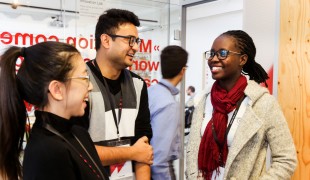- 7783
- 540
- 14
- 9
- 0
- Help Ukraine
About the solution
The watch was designed for both sighted and visually impaired people, allowing people to tell the time by touching the piece.
The design indicates hours and minutes through two rotating ball bearing set in concentric grooves around the timepiece’s face and perimeter. The ball’s positions are measured against raised hour indices around the face. All is connected by magnets to the Swiss quartz movement, and the balls can be realigned by twisting the wrist.
Hyungsoo, who founded his own company Eone, both to develop and sell the device, had the idea for this innovation during a class at MIT, when a blind class mate asking him the time. The entrepreneur noticed a was wearing talking watch that said the time out loud when he pressed the button, which was not convenient for all daily life situations.
“I went home that afternoon and spent the whole day googling “watch for the blind” hoping to discover something better. But they don’t exist! I found some cool tactile watches, but they were all “concept only” and didn’t exist in real world. That surprised me quite a bit. It’s the 21st century, and there are still many people out there for whom checking time is a huge challenge. All the watches and clocks available require vision. None of them work if you can’t see”, the inventor recalled.
With the help from designers and engineers, he came up with a prototype (was a bulky braille watch with dots that changed their combination each minute).
To further develop the product, Hyungsoo launched a Kickstater campaing, which allowed him to get nearly $600,000.
The piece can be bought online from 309€.
Adapted from: http://nyti.ms/2vyt2L8
More info: https://www.eone-time.com
https://youtu.be/e32wEt3iJhA
This solution shall not include mention to the use of drugs, chemicals or biologicals (including food); invasive devices; offensive, commercial or inherently dangerous content. This solution was not medically validated. Proceed with caution! If you have any doubts, please consult with a health professional.
DISCLAIMER: This story was written by someone who is not the author of the solution, therefore please be advised that, although it was written with the utmost respect for the innovation and the innovator, there can be some incorrect statements. If you find any errors please contact the patient Innovation team via info@patient-innovation.com
-
-
357
-
0
-
4123

Using AI to allow blind people to find familiar faces
COMMUNICATION: Communicating, whether by speaking, listening, or other means
Social interaction
Blindness
5 Senses support devices: (glasses, hearing aids, headphones...)
Body-Worn solutions (Clothing, accessories, shoes, sensors...)
App (Including when connected with wearable)
AI algorithm
Assistive Daily Life Device (to help ADL)
Difficulty communicating with environment
Confusion
Regaining sensory function
Promoting self-management
Promoting inclusivity and social integration
Improving Speech and Communication
Raise awareness
Ophthalmology
Pediatrics
United States
-
-
-
329
-
0
-
4082

Two blind brothers develop a clothing line for the visually impaired.
COMMUNICATION: Communicating, whether by speaking, listening, or other means
(SELF)-CARE: DRESSING: Dressing independently.
Blindness
Body-Worn solutions (Clothing, accessories, shoes, sensors...)
Website
Vision problems
Regaining sensory function
Promoting self-management
Promoting inclusivity and social integration
Ophthalmology
United States
-
-
-
451
-
0
-
6531

Visually impaired patient creates company to build affordable glasses
-
 en
en